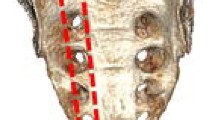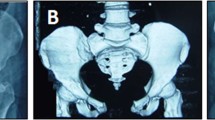Abstract
Introduction
A clinical series of patients was studied to compare the functional score after the use of a single versus two percutaneous iliosacral screws for unstable posterior pelvic ring fractures with or without anterior fixation with the aim to explore if the addition of a second screw would provide better results regarding the functional outcome score.
Materials and methods
This case series includes 77 patients with an average of 32.6 years who suffered unstable posterior pelvic ring fractures. Forty-six were Tile type C and 31 were Tile type B. Patients underwent closed reduction and were fixed using percutaneous fluoroscopic-guided iliosacral screws in the supine position with 1 screw in 50 fractures, 2 screws in 37 fractures, 2 fractures were fixed with plates after ORIF, and in 6 cases (out of the bilateral cases) the undisplaced side was unfixed. Postoperatively three patients were lost to follow up and 74 patients (84 posterior fractures fixed with screws) were followed up for a mean of 37.4 months (range 6–151 months) and were evaluated using the Majeed score (1989).
Results
Clinical union occurred in all the patients, although in two cases posterior fixation failed and was revised. Radiologically excellent reduction was achieved in 55 patients (71.4 %), good in 16 (20.8 %), fair in 6 (7.8 %) and none had poor reduction. Statistically; among 62 cases that completed the Majeed score evaluation at the last follow-up session, there was no significant difference p value 0.051 between two groups. We also compared Majeed score in Tile B and C fractures fixed with one versus two screws.
Conclusion
The addition of a second screw for posterior fixation did not show any statistically significant difference regarding functional outcome.
Level of evidence
Level IV clinical trial.
Similar content being viewed by others
References
Moed BR, Geer BL. S2 iliosacral screw fixation for disruptions of the posterior pelvic ring: a report of 49 cases. J Orthop Trauma. 2006;20:378–83.
Moed BR, Kellam JF, McLaren A, Tile M. Internal fixation for the injured pelvic ring. In: Tile M, Helfet DL, Kellam JF, editors. Fractures of the pelvis and acetabulum. 3rd ed. Philadelphia: Lippincott Williams and Wilkins; 2003. p. 217–93.
Routt C Jr, Simonian P, Mills W. Iliosacral screw fixation: early complications of the percutaneous technique. J Orthop Trauma. 1997;11(8):584–9.
Routt ML Jr, Nork SE, Mills WJ. Percutaneous fixation of pelvic ring disruptions. Clin Orthop Relat Res. 2000;375:15–29.
Van den Bosch EW, Van Zwienen CM, Van Vugt AB. Fluoroscopic positioning of sacroiliac screws in 88 patients. J Trauma. 2002;53:44–8.
Giannoudis PV, Tzioupis CC, Pape HC, Robert CS. Percutaneous fixation of the pelvic ring: an update. J Bone Joint Surg. 2007;89-B(2):145–54.
Sagi HC, Ordway NR, Di Pasquale T. Biomechanical analysis of fixation for vertically unstable sacroiliac dislocations with iliosacral screws and symphyseal plating. J Orthop Trauma. 2004;18:138–43.
Yinger K, Scalise J, Olson SA, Bay BK, Finkemeier CG. Biomechanical comparison of posterior pelvic ring fixation. J Orthop Trauma. 2003;17(7):481–7.
Simonian PT, Routt MLC Jr, Harrington RM, et al. Internal fixation for the transforaminal sacral fracture. Clin Orthop Relat Res. 1996;323:202–9.
Comstock CP, Van der Muelen MCH, Goodman SB. Biomechanical comparison of posterior internal fixation techniques for unstable pelvic fractures. J Orthop Trauma. 1996;10:517–22.
Majeed SA. Grading the outcome of pelvic fractures. J. Bone Joint Surg. 1989;71-B:304–6.
Matta JM, Tornetta P. Internal fixation of unstable pelvic ring injuries. Clin. Orthop Relat Res. 1996;329:129–40.
Suzuki T, Shindo M, Soma K, Minehara H, Nakamura K, Uchino M, Itoman M. Long-term functional outcome after unstable pelvic ring fracture. Trauma. 2007;63(4):884–8.
Mullis B, Sagi C. Minimum 1-year follow-up for patients with vertical shear sacroiliac joint dislocations treated with iliosacral screws: does joint ankylosis or anatomic reduction contribute to functional outcome? J Orthop Trauma. 2008;22(5):293–8.
Mears SC, Sutter EG, Wall SJ, Rose DM, Belkoff SM. Biomechanical comparison of three methods of sacral fracture fixation in osteoporotic bone. Spine. 2010;35(10):392–5.
Van Zwienen CM, van den Bosch EW, Snijders CJ, Kleinrensink GJ, Van Vugt AB. Biomechanical comparison of sacroiliac screw techniques for unstable pelvic ring fractures. J Orthop Trauma. 2004;18(9):589–95.
Tornetta P, Matta JM. Outcome of operatively treated unstable posterior pelvic ring disruptions. Clin Orthop Relat Res. 1996;329:186–93.
Matta J, Saucedo T. Internal fixation of pelvic ring fractures. Clin Orthop Relat Res. 1989;242:83–7.
Griffin DR, Starr AJ, Reinert CM, Jones AL, Whitlock S. Vertically unstable pelvic fractures fixed with percutaneous iliosacral screws: does posterior injury pattern predict fixation failure? J Orthop Trauma. 2006;20(1):S30–6.
Pohlemann T, Bosch U, Gänsslen A, Tscherne H. The hannover experience in management of pelvic fractures. Clin Orthop Relat Res. 1994;305:69–80.
Tornetta P, Dickson K, Matta JM. Outcome of rotationally unstable pelvic ring injuries treated operatively. Clin Orthop Relat Res. 1996;329:147–51.
Gruen GS, Leit ME, Gruen RJ, Garrison HG, Auble TE, Peitzman AB. Functional outcome of patients with unstable pelvic ring fractures stabilized with open reduction and internal fixation. J Trauma. 1995;39:838–45.
Van Den Bosch EW, Van Der Kleyn R, Hogervorst M, Van Vugt AB. Functional outcome of internal fixation for pelvic ring fractures. J Trauma. 1999;47:365–71.
Cole JD, Blum DA, Ansel LJ. Outcome after fixation of unstable posterior pelvic ring injuries. Clin Orthop Relat Res. 1996;329:160–79.
Conflict of interest
Dr Sherif Khaled, Omar Soliman and Mohamed Abdel Wahed declare that there are no conflicts of interest and we all hereby declare that we did not receive grants or financial support from any company or individuals.
Ethical standards
The study was approved by the ethical committee of the orthopedic department, Cairo University.
Author information
Authors and Affiliations
Corresponding author
Electronic supplementary material
Below is the link to the electronic supplementary material.
Rights and permissions
About this article
Cite this article
Khaled, S.A., Soliman, O. & Wahed, M.A. Functional outcome of unstable pelvic ring injuries after iliosacral screw fixation: single versus two screw fixation. Eur J Trauma Emerg Surg 41, 387–392 (2015). https://doi.org/10.1007/s00068-014-0456-x
Received:
Accepted:
Published:
Issue Date:
DOI: https://doi.org/10.1007/s00068-014-0456-x




